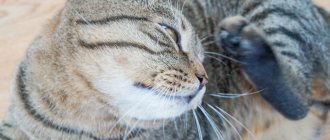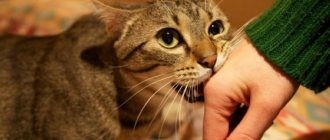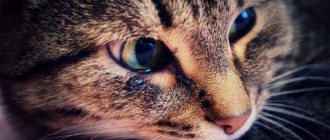Have you ever thought that the forces of nature are as powerful as they are fragile? Life does not stand still; dynamically developing humanity continually reaps the consequences of its rapid ascension to the throne of the “crown of nature.” Deforestation, agricultural development, targeted extermination of one or another animal species, poaching, global warming in the end - all this does not pass without leaving a mark on the inhabitants of flora and fauna. Life in the bosom of nature is far from easy - numerous species of animals wage a desperate struggle for survival, and the strongest always wins. One way or another, even if not directly, it is man who becomes the cause of the extinction of one or another animal species.
The topic for our conversation today will be rare representatives of the cat family, which are gradually disappearing from the face of the Earth.
Amur tiger
Despite conservation measures, the population of the Amur tiger is recovering very slowly.
It is also Siberian, it is Far Eastern, it is also Ussuri. This noble, incredible beast is the largest representative of the cat family and the only one of the tiger species who can survive in the harsh conditions of the Ussuri forests. The population of the ruler of the taiga declined rapidly from the end of the 19th century to the 30s of the last century, until it reached 20-30 individuals! The extermination of the species was facilitated not only by targeted poaching for the beautiful striped skin and other parts of the tiger carcass for further sale to Asian countries, but also by a reduction in the number of ungulates in the tiger’s habitat and active deforestation of taiga areas. As of 2015, according to the tiger census, 520-540 Siberian tigers live in the Russian Far East. The animal is listed in the Red Book and has the status of an “endangered species,” but there is still hope for the Amur tiger.
How does a manul live and what does it eat?
Pallas's cat lives in fairly harsh climatic conditions, with low temperatures and sudden changes in weather. The Pallas's cat prefers low snow cover, as its short legs do not allow it to move through deep snow. Therefore, the wild cat Pallas's cat is most numerous in areas with little snow.
Pallas's cat lives in steppes and semi-desert areas of mountains, choosing places with thickets of bushes, the presence of stone deposits and rock cracks. In the mountains, the manul cat rises to 3-4.5 km above sea level. It is rare in lowlands and forest belts.
The Pallas' cat lives sedentary and solitary, usually being active at dusk and early in the morning. During the daytime, he sleeps, hiding in a shelter. The wild manul makes its shelter under stones, in old burrows of marmots, foxes and badgers, as well as in small caves and rock crevices. The Pallas's cat is a territorial predator that jealously guards its territory and does not like guests, so it expels any unwanted visitor.
The color of the Pallas cat serves this wild cat as a kind of camouflage, which helps him in hunting and allows him to remain unnoticed by prey. However, the manul cat is one of the most clumsy and slow representatives of the cat family. But excellent eyesight and hearing allow him to be a skilled catcher.
Pallas's cat feeds on various mouse-like rodents and pikas. Occasionally, Pallas's cat feeds on hares, birds, gophers and marmots. Manul catches its prey by cunning. He waits for her at the hole or watches for the victim, hiding near the stones, after which he attacks, making a sharp lunge. This wild cat is very careful when hunting. Pallas's cat is not able to run fast, so chasing prey is not his strong point. In summer, the Pallas's cat feeds on various large insects, in case of a shortage of rodents.
Despite its harsh appearance, the Pallas's cat is not aggressive. Pallas's cat has practically no enemies; only wolves and large birds of prey pose a danger to this wild cat. The animal Pallas' cat is not one of those who is in a hurry to start a showdown and repel the enemy. This cat is trying to flee and lie down in a shelter. But when the Pallas cat is caught by surprise and there is no escape route to the shelter, then he begins to snort menacingly and bares his sharp teeth.
Snow Leopard
The snow leopard blends perfectly with the surrounding nature, but this will not save it when it meets a person.
Neither does the snow leopard or the snow leopard. The “ghost” predator lives mainly in the mountainous regions of Central Asia. The secretive lifestyle, as well as the inaccessibility of the snow leopard's habitats, makes it difficult to estimate the population, but experts believe that the number of this species is continuously declining. The main reason for the extinction of the snow leopard is the illegal hunting of the animal for its magnificent skin. A big problem is the undeveloped defensive behavior of the snow leopard, which, when meeting a person, prefers to timidly freeze against the backdrop of mountain slopes instead of fleeing from an armed poacher like the plague. The lack of enemies of the snow leopard among other predators played such a cruel joke. As you understand, such encounters usually end in death for the animal.
The number of snow leopards, according to WWF, is about 4,000 individuals; only 70-90 snow leopards live in Russia.
Caucasian jungle cat
House prefers to live near bodies of water, hiding in the thickets of cattails.
This cute fellow inhabits the Caucasus, Iran and the regions of Turkey bordering Transcaucasia. In Russia, it can be found in the Volga delta, in cattail and reed thickets. Another name for this species is swamp lynx or house. The number of Hausas has a pronounced downward trend; according to approximate data, in Russia the population barely reaches 500 individuals.
In some regions, the population of the jungle cat is close to extinction, the reason for this is the anthropogenic impact on the reed and reed lands in which the house lives (draining wetlands, burning and mowing down thickets). The bog lynx does not tolerate frost well, so particularly cold winters also contribute to a decline in the population. By the way, the House sometimes crosses with ordinary domestic cats; there is even a special breed of Chausie cats, for which a jungle cat was used.
Cheetah
Female cheetah with cubs
The fastest predator of the cat family is the cheetah. Distributed throughout Africa, as well as in the Middle East. The cheetah is significantly different from all other big cats, since, like canines, it is able to pursue prey over fairly long distances (cats, as a rule, do not run after prey, they prefer to kill it by pouncing from cover in one powerful, deadly leap), and also has non-retractable claws.
As of 2007, there are only 4,500 adult cheetahs in Africa, and the Asiatic cheetah subspecies found in Iran numbers no more than 60 individuals. Factors such as a decrease in the number of ungulates and persecution by humans have led to the vulnerability of the species. Cheetahs reproduce very poorly in captivity due to the peculiarities of social behavior; moreover, all existing cheetahs are close relatives of each other, and inbreeding always leads to genetic degeneration of the species. Perhaps due to inbreeding, more than half of all cheetah cubs do not survive one year.
Fishing cat
The fishing cat is an excellent swimmer and even dives in search of fish.
An inhabitant of the tropical forests of Southeast Asia, the fishing cat is an excellent swimmer and is not at all afraid of water. There are membranes on its paws that prevent the claws from being fully retracted, but help in fishing. In 2008, the fishing cat joined the list of endangered species. This is all due to the fact that the wetlands chosen by her are drained and developed by humans. The population of fishing cats numbers about 10,000 adults.
Kalimantan cat
A Kalimantan cat living in the Pulong Tau Nature Reserve.
Malaysia A little-studied species of wild cats lives on the island of Borneo (Kalimantan). There is no reliable data on the way of life, as well as the number of Kalimantan cats, since the animal behaves extremely carefully and the likelihood of meeting it in nature is extremely low, especially considering the active deforestation of the Kalimantan forests. A live specimen can fetch $10,000. The estimated population ranges from 50 to 2,500 mature individuals.
Description of Pallas's cat
The description of the Pallas's cat can begin with its appearance. The Pallas cat looks similar to a regular cat, only larger and fluffier. The dimensions of the Pallas's cat range from 50 to 65 cm with a tail length of up to 30 cm. The Pallas's cat weighs from 2 to 5 kg. The wild manul cat differs from an ordinary cat in its more massive body, short strong legs and very thick six. By the way, six Pallas' cats can reach a length of 7 cm. The Pallas cat has the fluffiest and thickest fur among cats.
In the description of the manul, it should be noted that this cat has a rather angry appearance, which makes it very memorable. The Pallas's cat looks stern due to the peculiar “whiskers” on its cheeks, which are formed by tufts of long hair. The Pallas' cat animal has a wide, flattened head and small, widely spaced, rounded ears. Pallas' cat's eyes are very expressive and yellow in color.
Surprisingly, the pupils of these cats’ eyes, unlike the pupils of a domestic cat, do not narrow in bright light, but remain round. The wild Pallas cat has a long fluffy tail with a rounded tip. The color of the Pallas's cat is combined and is represented by the colors of light gray and yellowish-brown.
Manul looks unusual. Since the ends of the hairs of its fur are painted white, it seems as if the Pallas' cat's fur is dusted with snow or covered with frost. The back of the body and tail have narrow transverse stripes of a dark color. Black stripes stretch from the corners of the eyes and along the sides of the muzzle, and there are specks of dark color on the forehead. The lower part of the animal's body is brown with a white coating. The tip of the tail is colored black. The manul cat has sharp teeth and claws.
The Pallas cat animal has a very specific appearance. It is believed that this cat is related to Persian cats. The wild manul cat was discovered by the German scientist Peter Pallas, who in the 18th century conducted research on the coast of the Caspian Sea. It was in his honor that the manul received the name “Pallas cat”.
Sumatran cat
The flat-headed cat is very cautious and is predominantly nocturnal.
Another wild cat from southeast Asia is the flat-headed or Sumatran cat. It was considered extinct in the mid-1980s, but was rediscovered in Malaysia in the 1990s. This cat is very tiny (1.8-2.7 kg) and prefers to settle near the water, where you can splash around happily and feast on fish, frogs, and other tasty aquatic inhabitants. The flat-headed cat is active at night and is usually not visible to people, so the species has been little studied. There is information that the last meeting of a person with this cat was in 2005. There is no data on the number of livestock, but the Sumatran cat is listed in the International Red Book as an endangered species due to pollution of water bodies, destruction of habitats and depletion of fish resources.
Andean cat
The Andean cat prefers to live at altitudes of up to 5000 m above sea level.
The rarest cat species in South America. The habitat, as the name suggests, is the Andes. The first video images of this cat appeared only in the early 2000s. The species has been little studied - the Andean cat is difficult to observe, since it prefers to hide in low bushes and grass. There is no information on the number, but scientists suggest that the population of the Andean cat is extremely small due to the fact that the population of small rodents living in the Andes has also fallen significantly over the past few decades.
Iberian lynx
The Spanish lynx is the rarest and smallest species of lynx.
The rarest species of lynx and one of the rarest species of mammals. It lives exclusively in the mountainous areas of southwestern Spain, although it was previously distributed throughout Spain and Portugal. The population of the Iberian (or Sardinian, Spanish) lynx in 2005 was only about 100 adults. The Spanish lynx is still persecuted by humans despite the fact that hunting it has been prohibited since the 70s.
Iberian lynx
Another name for the species is “Spanish lynx”. This is perhaps one of the rarest animals on our planet. There are very few of them left - about 156 individuals, almost all of them live in Doñana, a Spanish national park. This lynx has not been seen in the wild for a long time.
Source: tuvamarket.ru
The Spanish lynx prefers Mediterranean terrain with low bushes, where many rabbits live - its main prey.
The disappearance of this species began after the number of European rabbits decreased. Since then, this cat has been under special human protection.
Clouded leopard
The clouded leopard is one of the ancient species of cats.
The beautiful spotted-marbled coat of the clouded leopard, which lives in the tropical forests of southeast Asia, is still a valuable prey for poachers. Deforestation also played an important role in reducing the species' population. As of 2008, the clouded leopard population numbered 10,000 adults and is considered endangered. A subspecies of the clouded leopard, the Taiwan leopard, was already declared extinct in 2013.
Bornean clouded leopard
The Bornean leopard is active mainly at night.
Despite its similar name to the previous leopard, the Bornean or Kalimantan leopard is not a subspecies of it. The Bornean leopard lives in the rain and mangrove forests of Borneo and Sumatra. There is no reliable data on its abundance, but the species is classified as vulnerable due to degradation and transformation of wooded areas, which are the habitat for this species, into rubber plantations.
Where does the manul live?
Pallas's cat lives in Central and Central Asia. The habitat of the Pallas's cat covers territories from Southern Transcaucasia and western Iran to Transbaikalia, Mongolia and Northwestern China. Depending on their territorial affiliation, Pallas' cats have slight differences in color and size. On the territory of Russia, the Pallas's cat lives in several areas: eastern, Transbaikal and Tuva-Altai. In these areas, manul is distributed in the steppe and forest-steppe zones.
In total, there are 3 subspecies of manuls: regular, Central Asian and Tibetan. The first subspecies has a typical color and this Pallas's cat lives in Mongolia and western China. The second subspecies of Pallas's cat lives in Pakistan, Kazakhstan, Uzbekistan, Afghanistan, Turkmenistan, Iran, Kyrgyzstan and Afghanistan. It is characterized by a reddish color, with clear stripes of a reddish tint. The third subspecies of Pallas's cat lives in Tibet, Nepal and Kashmir. This subspecies has gray fur with pronounced dark stripes. In winter, the color of the Tibetan Pallas's cat becomes silver.
Black-footed cat
The black-footed cat is the smallest representative of wild cats in Africa.
A resident of South Africa, the black-footed cat (other names - small spotted cat, informal ant tiger) is one of the smallest wild cats. The weight of an adult male is from 1.5 to 2.4 kg. Black-footed cats often occupy abandoned burrows of other animals or settle in termite mounds. Although the cat is not of interest to hunters, it is nevertheless considered a threatened species, since it often dies from poisons and traps set for jackals, and besides, the places chosen by it are actively developed by people and converted into pastures for livestock. The black-footed cat interbreeds with domestic cats, which also contributes to the degradation of the species.
Reproduction and offspring
Pallas' cat breeds once a year. The rut occurs between February and March. The male's mating call resembles a cross between a quiet bark and an owl's cry. Estrus in females does not last long, approximately 42 hours. When the rut begins, several partners show interest in the female, who is ready to mate, and periodically start violent fights. Pregnancy lasts from 66 to 75 days (average 60), and spotted kittens are born in April - May or late May - June. A litter usually contains 3–5 blind young, but there may be one or seven.
Each newborn weighs from 0.3 to 0.4 kg and is about 12 cm long. Kittens open their eyes after 10–12 days and change their fur at 2 months of age, when they already weigh 0.5–0.6 kg. Upon reaching 3–4 months, the young begin to hunt. Not all young Pallas' cats survive to reproductive age, which occurs at 10 months. Many kittens die in infancy from acute infectious diseases.
Chinese cat
In Chinese, the Gobi cat's name is "huang mo mao", which means "yellow-furred cat."
Also called the Gobi cat, it is a Chinese endemic and is found primarily in the mountainous and steppe regions of northwestern China. Outwardly it resembles a jungle cat. The Chinese cat is a rare species and belongs to the vulnerable species. According to approximate data, the number of Chinese cats is less than 10,000 mature individuals. The Chinese cat is pursued by humans because its skin is of interest to artisans. There is evidence that the campaign to exterminate rodents, which are the main food for this feline, carried out in the late 50s played a big role in reducing the number of Gobi cats.
Range, habitats
Pallas's cat is quite widespread - in Central and Central Asia, in the south of Siberia (from the coast of the Caspian Sea to Transbaikalia). Pallas's cat inhabits Transcaucasia, Mongolia, Western China and Tibet, as well as Afghanistan, Iran and Pakistan.
Important! In recent years, the habitat of the Pallas's cat, almost completely exterminated in the open steppes, has become fragmented, turning into isolated zones.
In our country there are three such zones (eastern, Transbaikal and Tuva-Altai), and it is allowed that there is no gap between the second and third:
- eastern - the steppes of the Chita region (between Shilka and Argun) to Onon in the west;
- Transbaikal - within the boundaries of the forest-steppe and steppe regions of Buryatia (Dzhidinsky, Selenginsky and Ivolginsky) to the latitude of Ulan-Ude;
- Tuva-Altai - extreme southeast of Tyva and Altai
The Pallas's cat looks for rocky outcrops and wide areas with bushes where it could hide during the day, which is why it is attached to certain landscapes - small hills, mountains (with adjacent plains) and mountain ridges, foothills and spurs of ridges. Wherever the Pallas's cat lives, there is a sharply continental climate with extremely low winter temperatures (down to -50° C) and shallow snow.
Chilean cat
Kodkod is an excellent climber and excellent tree climber.
Another predatory baby comes from South America. Its other name is kodkod. The weight of an adult cat is a maximum of 2.7 kg. The species is included in the International Red Book as vulnerable; the population of the species is about 10,000 adult animals. The species is threatened by both poachers and habitat loss (deforestation).
Oncilla
Oncillas living in Brazil, despite their modest size, catch even small primates.
The name of this cat means “little jaguar.” Oncilla lives in mountainous and subtropical cloud forests of South America. In the wild, the species is practically unstudied. The oncilla's exquisite fur makes this small cat a desirable target for poachers—an estimated 84,000 oncilla skins were seized in the early 1980s!
Hunting for oncilla is prohibited, but its numbers are small (about 50,000 adult cats) and are constantly declining due to logging and the conversion of forest areas to coffee plantations.
Forest cat at home
Catching a wildcat is very difficult. There are certain features of maintenance and care at home. The character of a wild cat bears little resemblance to its domestic relative, although outwardly they differ only in size.
Taming a forest cat is almost impossible. Even the offspring of a domestic cat and a forest predator are very difficult to raise. Wild habits and uncontrollable temperament are transmitted at the genetic level.
The diet of the European wild forest cat should be as close to natural as possible. It is strictly not recommended to take a forest predator into your home if there are already pets there.
Coexistence is almost impossible; predatory habits, freedom-loving disposition and independence make keeping a forest cat at home a difficult task.
Iriomotean cat
The Iriomote Island cat is a subspecies of the Bengal cat.
An extremely rare species that is endemic to the subtropical Iriomote Island, part of Okinawa Prefecture, Japan. This cat originally had a limited range and an extremely modest population. At the moment, the number of Iriomotey cat is no more than 100 adult individuals.
Some locals consider its meat a delicacy, which greatly harms the species. Crossbreeding with wild cats of other species also contributes to the decline of the Iriomotean cat. The species is on the verge of extinction, therefore it is protected and listed in the International Red Book.
Description of the animal
The weight of the female ranges from 3 to 6 kg, the male can reach 6.8 kg. There were individuals that gained weight of 11 kg. The body reaches a length of 50 cm. The head is round, the eyes are expressive. The eyes have a third membrane that protects the organ of vision from damage.
The voice is hoarse, makes sounds characteristic of cats, but with a much greater emotional coloring. It not only meows, but also growls, hisses, snorts, and howls.
The tracks of a wild animal are the same as those of a domestic animal. The only difference is the larger size. It climbs trees well and has sharp retractable claws on its paws. The hind legs have four toes, the front legs have five.
| Scientific classification | |
| Kingdom | Animals |
| Type | Chordata |
| Class | Mammals |
| Squad | Predatory |
| Family | Felines |
| Genus | Cats |
| View | forest cat |
| Subspecies | Caucasian forest cat |
| Latin name | Felis silvestris caucasica |
In the mouth there are sharp fangs, with the help of which the animal holds and kills prey, and molars, intended for chewing meat. The tongue is hard, allows you to lick meat and care for the coat.
What does it look like
The Caucasian cat looks like an ordinary domestic mongrel cat, except that it is larger in size. The coloring is gray, with a small reddish mark. There is a black stripe along the ridge. There are also short transverse stripes on the sides and on the head to the back of the head.
The belly, throat and groin area are covered with light yellow fur. There are sometimes dark spots on the stomach. The tail is striped, with dark rings on a gray background. There can be from three to eight. In summer the color is brighter than in winter. During the cold season, the coat becomes thicker.
This coloring allows the animal to camouflage well while hunting. The cat goes hunting at night, and often sits in ambush.
Character and lifestyle
Settles in hollows, crevices, heron nests, abandoned burrows of badgers or foxes. May live in abandoned houses or near housing. It can also live in thickets of bushes or reeds. Prefers to lead a solitary lifestyle. Each individual has its own controlled territory. Usually it does not exceed three kilometers.
The peculiarity of the animal is that to mark the territory, the cat not only sprays urine, but also uses the secretion of special glands that are located around the mouth, on the forehead and near the base of the tail. The cat rubs against different surfaces and leaves an individual smell.
This is a solitary animal, but in places with high numbers, a certain hierarchy is formed between individuals that are often in contact. To protect its own territory, it can be belligerent.
The animal prefers to sit in ambush for a long time and wait for the right moment to attack. A sharp jump from an ambush can reach three meters. Sometimes it catches up with prey, but such cases are very rare.
A wild forest cat can swim, but will not get into the water without a special reason.
What does it eat?
The basis of the diet is small rodents, lizards and birds. It can also hunt pheasants or small-sized artiodactyls (young individuals). Very rarely catches fish or crayfish. Can also eat roots or some herbs.
During periods of food shortage, it can hunt hares or domestic animals. It can also destroy nests for eggs or chicks. Sometimes it feeds on young cereals, fresh carrion or fruits.
The wild cat is a highly successful hunter and poses a danger to river rats, waterfowl, squirrels, stoats, young large animals, as well as injured goats and other herbivores. Often attacks domestic animals and gets into fights with dogs.
When hunting large prey, it tries to gnaw through the carotid artery. In hunted large animals, the liver, heart, and lungs are primarily eaten.
Where does it live?
The animal is found in the forests of Central Asia, Western and Eastern Europe. Prefers deciduous and fir forests. The Caucasian forest cat on the territory of the Russian Federation is found only in the Krasnodar Territory. The number of this species is so small that records are kept of each individual.
This species is considered the largest among forest cats. In the Red Book, this species is number three, as one of the rarest species that are on the verge of extinction. Found in the lower reaches of the Kuban and Terek.
Reproduction
The mating season lasts from February to March. The female secretes special substances that attract males. A cat bears kittens for approximately 70 days.
There are three to five babies in the litter, which feed on mother's milk for four months. Only the female is responsible for raising the cubs, although cases have been recorded when the male brought prey to the den of the female with the cubs.
If the first litter of the season dies, the female is able to become pregnant again. Sexual maturity occurs at 9-10 months (females) or three years (males). Life expectancy in the zoo is 30 years, in the wild - 15.
Natural enemies
Lynxes, jackals, jungle cats, martens and foxes can pose a danger to the animal. In case of a threat to life, the animal develops high speed or climbs to the tops of trees.
Wintering
During snowy and cold winters, annual seasonal migrations occur to places more suitable for habitation. Deep snow prevents rapid movement, which is why the wild cat is forced to change its place of residence. If conditions are favorable, the animal spends the winter where it lives.
Amur forest cat
The Amur cat lives in most reserves of the Primorsky Territory
. Another name is the Far Eastern cat. It is a subspecies of the Bengal cat. Habitat: Far East, coast of the Sea of Japan. The species is considered rare and is listed in the Red Book of the Russian Federation. The population of the Primorsky Territory numbers about 2-2.5 thousand adult individuals, and the population is currently growing. The species is threatened by weather conditions, habitat degradation, and interbreeding with domestic cats. The population of the Far Eastern cat on the Japanese island of Tsushima (where the species is called the Tsushima leopard cat) numbers only about 100 individuals and is under state protection.
Origin story
In the first epoch of the Cenozoic era, 60 million years ago, a family of terrestrial carnivorous predators formed on earth. From the family of mammals from the order of predators came the genus of felines Pseudoailurus, from which the subfamilies of cats originate: small, large and saber-toothed cats.
The forest cat comes from the subfamily of small cats. Ancient small predators lived in North America, Asia and Europe. Animals have taken root well on the American continent; the most exotic representative of felines is the American forest cat, the ocelot.
Forest cats are predators, the history of whose origin stretches back to centuries ago. In a variable climate, from periods of drought to abnormally low temperatures, wild cats have survived.
Having survived natural disasters, wild forest cats began to adapt to life in harsh, impassable places. Small forest predators have taken root well in forests, hence the name forest cat.
Felis silvestris is the Latin name for the subspecies, meaning wild cat. The forest wild cat is listed in the Red Book. Purebred extinction of wild forest cats occurs due to mating with homeless outbred felines.
Rusty cat
The smallest cat in Asia spends most of its time on the ground, although it climbs trees very well.
The smallest representative of Asian wild cats (average weight of an adult animal is 1.6 kg). It lives only in India and Sri Lanka. The population, which is constantly declining, is about 10,000 adult cats. The species is threatened by changes in its natural habitat (deforestation). The rusty cat is often kept as a pet due to its playful, good-natured nature.
Diet of Pallas's cat
The Pallas cat's menu does not amaze with its variety - it consists of small rodents and occasionally small birds. The plowing of steppes for agricultural land (in terms of preying on livestock) looks twofold: on the one hand, rodents try to leave these places, on the other hand, they begin to accumulate near livestock camps and are more quickly discovered by Pallas’ cat.
The traditional Pallas' cat menu includes animals such as:
- voles and gerbils;
- hamsters and gophers;
- tolai hares;
- marmots (young ones);
- pikas;
- partridges and chukars;
- larks and other birds building nests on the ground;
- insects (summer)
The manul waits for the victim near holes or stones: if the hole is shallow, he scratches the unfortunate person with his paw.
This is interesting! By autumn (October - November), Pallas's appetite increases. They eat one and a half times more and gain weight uncontrollably. In winter (December - January), interest in food disappears, and the animals eat every other day.
In zoos, cats are given meat in combination with green cereals and bone meal, but their favorite dish is carcasses of rodents/quails specially bred for these purposes. Pallas' cats are fed in the evenings.
Far Eastern leopard
The Amur leopard reproduces extremely poorly in captivity.
The rarest subspecies of leopard is on the verge of extinction and is included in almost all protection documents. In the Primorsky Territory National Park “Land of the Leopard” there are only 87 individuals (as of 2017), about 12 more adult animals are in China. Huge damage to the Far Eastern or Amur leopard was caused by poachers. The illegal shooting of animals was caused by the widespread demand for skins and other parts of carcasses, which are used in oriental medicine, as well as unemployment and poverty of the population of the Primorsky Territory. The species is threatened by a reduction in the number of ungulates, habitat degradation and inbreeding, which causes genetic depletion of the species (due to a small population).
Sumatran tiger
The Sumatran tiger is very ferocious and can attack people.
It is endemic to the island of Sumatra, located in the western part of the Malay Archipelago. The Sumatran tiger is the smallest representative of the tiger species, but the most aggressive. The species is small in number and is endangered due to illegal hunting and habitat destruction. The cost of a Sumatran tiger carcass on the black market is $20,000. Sumatran tiger attacks on humans are not uncommon: at least 8 people have been killed by them since 2002. Listed in the International Red Book and the CITES Convention.
Source











